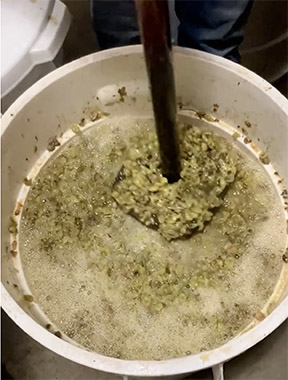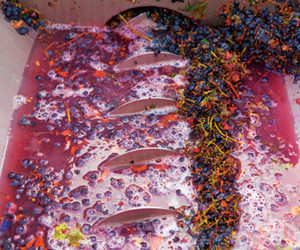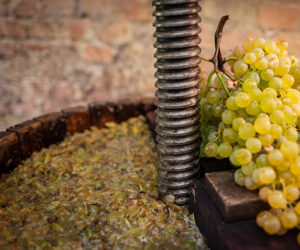
A fermentation experiment combining fresh apple cider with the pomace of our white winemaking has become an annual component of our fall in recent years.
We are part of a 12-person amateur winemaking group whose origins go back over 30 years, the second half of which we have been active members. Through the group we buy grapes from Lonesome Spring Ranch located in the warm, well-drained Rattlesnake Mountain AVA in Yakima Valley near Benton City, Washington. We vary our annual red and white grape variety selections to fit our interests — for the past six years we have made Roussanne, Sauvignon Blanc, Viognier, and Chardonnay.
We live on two acres in Olympia, Washington, with nine apple and pear trees of various sorts — some heritage trees (our house is 99 years old) — and some dwarf trees we have planted. Each year, we do cider crushes with friends. As none of our apple trees are specifically hard cider varieties, the results of our fermented cidermaking often have been unimpressive. Around the same time we began making cider we began to explore the world of “orange” wines — white wines that are fermented with the skins.
The combination of the two separate fermentations got us thinking. In 2017, we decided to take some of the pomace from our group’s Viognier crush/press and add it to our 10-gallon (38-L) fermenter of fresh-pressed apple cider. Our hope was that the skins, stems, seeds, and residual juice from the grapes would complement the apple cider to make a pleasing combination. We first doused it with sulfur dioxide for 24 hours and then pitched with a white wine yeast and fermented on the skins as one would do with an orange wine.
As the fermentation was slow, we left it on skins for two weeks and then pressed and racked in mid-October. Over the next 5 months, we racked two more times and also added oak chips in the carboy for final aging and then bottled in mid-March 2018. Notes from that first batch say the result was “damn good!”
We have continued this process the past seven years, each year using our apple cider (often with some pear juice added) and whatever grape pomace is available. Our experiences have included:
• A variety of yeasts: Lalvin K1-V1116 and other fruit-forward white wine yeasts.
• Adding some Petit Verdot pomace, resulting in a blush color cider.
• Adding a few cups of corn sugar to overcome low °Brix.
• Adding toasted oak cubes and barreling in an older 5-gallon (19-L) oak barrel.
Some batches have been better than others, but each has resulted in a light wine good for summer drinking, with a 7–9% ABV. Once or twice the results were very thin and without much nose or complexity of flavor. Higher skin-to-apple ratios seem to help add more vitality, and if the °Brix is very low (under 18), chaptalizing has improved the outcome. Thus far we have used taste and gut over firm data in adding sugar.
We think they are best when they have developed some natural carbonation, but a few batches held up fairly well without any bubbles. We now are experimenting with adding corn sugar and bottling in beer bottles to gain a slight carbonation.
Most recently, we re-used a small barrel where we had aged an experimental Port-style wine and found that it picked up a lot of Port-like flavors from the barrel, giving us yet another idea to pursue. How does an oak-aged, skin-contact apple Port sound?







